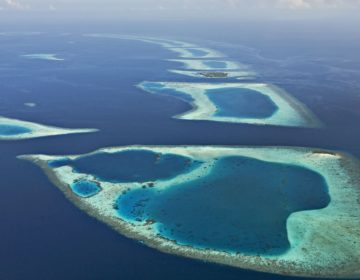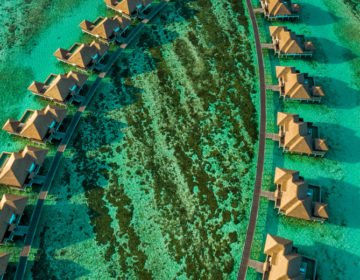Dhigu Thila
This long thila lies in the middle of Gulhee Dhekunu Kandu. The entrance across the face of the channel is flat and shallow with depths of around 15 meters or less. The thila runs east to west, rising to over 10 meters at the western end. The eastern end joins the shallow entrance to the channel. On the north and south sides of the thila, there is sand on the bottom that levels out at 20 to 25 meters. On the south side is a wall with overhangs and caves between 15 and 20 meters. There is a vibrant display of soft coral on the reef and sea fans in the caves. Fish life on the thila is prolific with large schools of basslet and snapper and aggregations of bannerfish and sweetlips.
The trough between the thila and Dhigufinolhu reef rises from 25 meters on the inside to 14 meters near the corner. In outgoing currents, this creates a funneling effect that sweeps up nutrients and zooplankton making it favorable feeding conditions for mantas. Divers often refer to this place as Manta Point.
 There is a vibrant display of soft coral on the reef.
There is a vibrant display of soft coral on the reef.
Diving Hints:
There are many ways to dive this channel depending on the current. If the current is not too strong, divers can venture across the entire entrance, and because the channel is not deep, they can finish their dive midway if running low on air. The thila can be dived separately or with Manta Point. If the mantas are about then, this channel provides plenty of entertainment.
 If the mantas are about then, this channel provides plenty of entertainment.
If the mantas are about then, this channel provides plenty of entertainment.
Miyaru Faru
The southern end of Fushidhiggaru Falhu is known for its sharks, which gives the reef its name. On the corner are overhangs at 17 meters and a sandy bottom at 20 meters. With an incoming current white-tip and grey reef sharks, eagle rays, Napoleon and sometimes hammerhead sharks can be seen on the corner.
 Sometimes hammerhead sharks can be seen on the corner.
Sometimes hammerhead sharks can be seen on the corner.
Kuda Giri Wreck
This steel wreck is located on the southwest side of a small reef west of Dhigufinolhu. It lies upright between 20 and 35 meters. It is an excellent reef for beginners and night divers.
 The Kuda Giri wreck is located on the southwest side of a small reef west of Dhigufinolhu.
The Kuda Giri wreck is located on the southwest side of a small reef west of Dhigufinolhu.
Maafushi Caves
There is one spectacular cave on the north side of a small reef between Maafushi and Dhigufinolhu. Its opening is on the reef top at five meters, and the cave drops through the reef to an opening at 20 meters. Eagle rays are often seen here. This is an excellent spot for unforgettable photographs.
Cocoa Corner
The north side of Biyaadhoo Kandu has many caves and overhangs near the corner between five and 20 meters. The channel wall is steep – at one point it is undercut from five to 20 meters – whereas the outside reef corner slopes more gently. The channel is quite deep, descending to 40 meters. Inside the channel 200 meters from the corner, is a large outcrop of reef 20 meters long at a depth of 30 meters. Turtles frequent the reef, as well as surgeon and black snapper.
Shaped like a teardrop, this 300-meter long thila is one of the most exciting dives in South Malé Atoll and boasts magnificent scenery, as well as prolific sea life. The west and north sides are the most spectacular, with the top at 16 meters. The reef top at the east end drops away to 20 meters, making it a challenging dive for experienced divers only.
At ‘Jack Corner,’ there is a cave at 23 meters with soft coral, but the main feature here are the dense schools of big-eye trevally and snapper. Sometimes there are dog-toothed tuna and barracuda.
There are several large outcrops of rock near the west corner on the north side covered in bright, soft corals. These are a focal point for black snapper, blue-fin jack, eagle rays, and sharks. On the reef edge, there are caves at 23 meters and overhangs full of exotic marine life.
 The main feature here are the dense schools of big-eye trevally (seen above) and snapper.
The main feature here are the dense schools of big-eye trevally (seen above) and snapper.
Diving Hints:
If the current is flowing out of the atoll, then timing is critical if divers want to begin at Jack Corner. Divers may have to start their dive well up-current, making a quick descent to the reef. If depth is limited to 25 meters, the sufficient bottom time can be obtained to explore all the major features of the reef. The further east along the thila divers go, the deeper the reef edge and caves become. Currents can be powerful, so it is essential that a safety balloon is carried for making open water safety stops.
 It is essential that a safety balloon is carried for making open water safety stops.
It is essential that a safety balloon is carried for making open water safety stops.
Kandooma Caves
One of the underwater marvels of the Maldives are the vast caves on the reef corner near Kandooma Island. They are among the largest caverns to be found in the tourist atolls. Just 50 meters from the corner are two huge caves close to one another: one is at 20 meters with a hole in the roof at 10 meters; the other is at a depth of 16 meters. The 16-meter cave is about 70 meters long and has a curly overhang blocking out much of the sun, so be sure to take a torch. Inside are yellow sponges, sea fans, and small tube corals, and sometimes giant moray eels.
 Inside are yellow sponges (seen above), sea fans, and small tube corals.
Inside are yellow sponges (seen above), sea fans, and small tube corals.
Further inside the channel are overhangs and another two caves, one of which starts at 10 meters and has a hole in the top at three meters. There are many grouper and squirrelfish to be found in the caves, and along the reef is clown triggerfish, Napoleon, sweetlips, and angelfish.
Guraidhoo Kandu – PROTECTED MARINE AREA
The entire Guraidhoo channel, between Guraidhoo Faru and Maadhoo Falhu, has been declared a Protected Marine Are. There are, in fact, two channels, Lhosfushi Kandu and Guraidhoo Kandu, separated in the middle by a reef known as Medhu Faru. The channel has an intricate reef system with many diving alternatives. It is one of the premier diving locations in the Maldives and the focus of plenty of diving activity in South Malé Atoll.
Lhosfushi Kandu
The channel on the north side of Medhu Faru has a very shallow, narrow sandy entrance 10 meters wide at a depth of five meters such that if you blink, you miss it. The channel deepens inside to a sandy bottom to 30 meters. There is plenty of fish life inside, including gobies, butterflyfish, schools of snapper, fusilier, tuna, Napoleon and white-tip reef sharks. There are also large morays, and during the south-west monsoon, there are manta rays. Another regular visitor is a guitar shark.
 Another regular visitor to Lhosfushi Kandu is a guitar shark.
Another regular visitor to Lhosfushi Kandu is a guitar shark.
Sandune
This is an adjoining reef one kilometer inside Lhohifushi Kandu with an undulating sandy bottom around 15 meters on the north side. Mantas are also known to frequent this reef.
Medhu Faru
The south side of Medhu Faru has many impressive features, making it one of the most scenic drift dives in the atoll. With an incoming current, divers can start on the outside reef where a long ledge at 30 meters sweeps around the corner into Guraidhoo Kandu. Visibility is usually very good with an incoming current and with wavering sea fans springing out from the ledge, soft coral in abundance and big fish – sharks, barracuda, and Napoleon – in the open ocean, this is a sensational start to an exhilarating dive.
Near the corner, the wall of the channel becomes more steep ad the current accelerates through the pass. A large rock draped in soft coral lies near the edge forming a small canyon at 18 meters. Sharks, trevally, tuna, and fusilier congregate here. The channel floor is at 35 meters and 10 to 15 meters, there are caves and ledges well worth a visit. One big overhang cuts through the reef from three to 30 meters. A sandy bay 250 meters inside the channel is a good starting point for a dive with an out-going current.
 Visibility is usually very good with soft coral in abundance.
Visibility is usually very good with soft coral in abundance.
Diving Hints:
Strong outgoing currents can be dangerous at Medhu Faru because of currents sweeping through both Guraidhoo and Lhosfushi Kandu, pushing divers away from the outside reef. Stay shallow on the outside corner at these times.
Guraidhoo Corner
With either an outgoing or an incoming current, Guraidhoo Corner promises a unique diving opportunity for viewing a wide range of fish. The outside reef has many reef fish, including schooling bannerfish, which always inhabits the same area, as well as turtles and many species of grouper.
Near the corner, big schools of fusilier, rainbow runner, tuna and trevally congregate, while on the corner at 25 meters, grey reef sharks and snapper prey on fish. A large tame Napoleon has become an identity on both sides of the channel and is quick to track down divers. A long cave with fans, sponges and soft coral at 16 meters on the corner is a quiet refuge, not only for cave-dwelling fish but for divers seeking a break from the currents.
 A large tame Napoleon has become an identity on both sides of the channel.
A large tame Napoleon has become an identity on both sides of the channel.
Inside the channel, a series of caves and overhangs occur at 10 meters while below are numerous outcrops of the reef. At one point inside the channel is a considerable overhang descending from the reef top at five meters to over 30 meters. With an outgoing current, a school of eagle rays often hover around the overhang at 20 meters. Along the bottom of the channel at 35 meters are white-tip reef sharks. Divers never get bored at this site, and each dive is full of discoveries.
Diving Hints:
Currents can be troublesome through this channel and dives may have to be aborted during spring tides. With a powerful incoming current, divers may find themselves being pushed onto the reef top at the corner, in which case it is better to stay below 15 meters. A whirlpool effect dragging divers up and down occurs near the big overhang. Stay close to the reef at these times. With strong outgoing currents, start well inside the channel and take care not to dive too deep, especially on the corner, as currents will drag divers outside, making it difficult to return to the reef.
Experience these once-in-a-lifetime dives and book your hotel here.
(Source: Dive Maldives: A Guide to the Maldives Archipelago. Tim Godfrey. Atoll Editions, 2015 / Nr. 1 Lion S Head. Recommendation: Nr. 2 Old Shark Point – Pdf )



